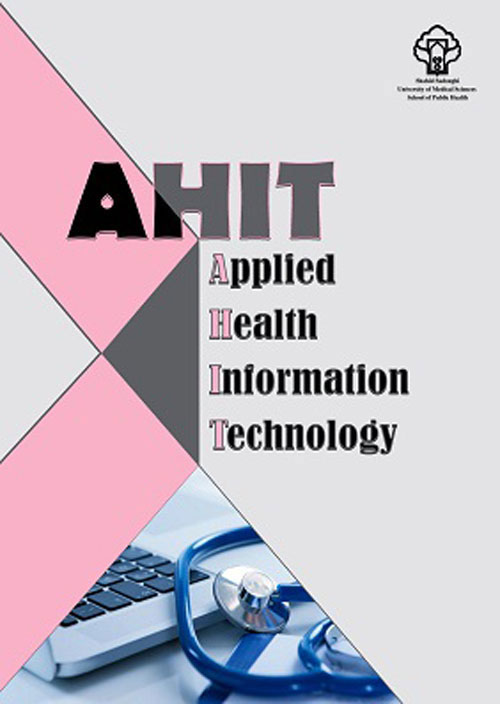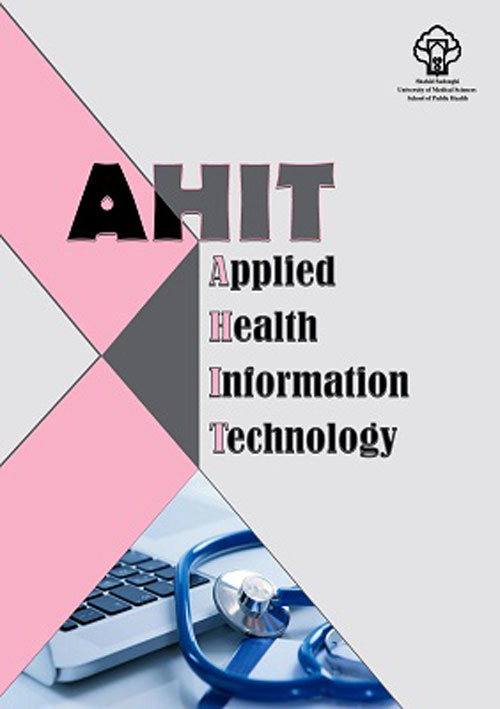فهرست مطالب

Applied Health Information Technology
Volume:2 Issue: 2, Summer-Autumn 2021
- تاریخ انتشار: 1400/09/24
- تعداد عناوین: 8
-
Page 1
Internet addiction is has been introduced as one of the fastest-growing addictive behavior which resulted in significant public health problems in a large number of people worldwide. Ivan Golberg, the psychiatrist, first used this term in an article in 1995. It defines as the excessive and repeated use of the internet in all areas of life (1). During the outbreak of COVID-19 in the world, information technology played an important role in responding to this epidemic. Since government social distancing guidelines are one of the most efficient methods for the suppression of coronavirus, the use of smart technologies as an efficient tool is inevitable (2).Also, the current situation has caused the researchers to focus on developing phone applications from the perspective of patients and healthcare workers to achieve better health self-management, provide timely and proper healthcare services, reduce costs, and improve the patient's medical experience (3). A variety of emerging Web-based technologies can be used for epidemic prevention and control [2, 3]. By applying these technologies, people will be less likely to seek outside their medical and non-medical needs and become infected with this dangerous virus, and more likely to stay at home and maintain social distancing during the Covid-19 pandemic (4).In a study, it was mentioned that "Internet addiction is a disorder that should have been considered in the fifth edition of the Diagnostic and Statistical Manual of Mental Disorders (DSM-V) since it is an impulsive-compulsive spectrum disorder" (5).In the COVID-19 crisis, with constantly emerging new mutations, people must use the Internet to provide their healthcare, education, and daily shopping needs. However, can be considered the excessive and repeated use of the Internet as a disorder or not?
Keywords: Internet, Addiction, COVID-19, Internet Addiction -
Pages 2-7Aim
The study aimed to investigate the viewpoints of medical students towards the development of telemedicine methods at the Army of the Islamic Republic of Iran (AJA) University of Medical Sciences.
MethodThis cross-sectional, descriptive-analytical study, which lasted 4 months, was performed on 117 medical students of AJA University of Medical Sciences in 2021. In doing so, a Stratified sampling method and researcher-made questionnaire were used to collect data. Thus, the inclusion criterion was being a medicine student and the exclusion criterion was the incomplete completion of the questionnaire.
ResultsStudents showed the most positive view (90.6%) regarding organizational factors to having a codified program in telemedicine development, and the most positive view towards high-speed Internet access (92.3%) concerning technology factors. In addition, as far as the stakeholders were concerned, they had the most positive view (70.1%) on community support for telemedicine development. As for information literacy, 88.9% emphasized computer and Internet skills. Also, 83.8% had the most positive view on raising awareness for telemedicine development regarding environmental factors.
ConclusionTo sum up, the students had the most positive attitudes towards comprehensive telemedicine development plan, high-speed Internet access, and community support for telemedicine development, computer skills, Internet, and awareness. Hence, it is recommended to enhance these factors to help the development and implementation of telemedicine in medical education.
Keywords: Telemedicine, Viewpoint, Medical Students, Army University -
Pages 8-16AimUsing educational websites can be effective in enhancing the health-related knowledge of patients suffering from osteoarthritis. This study aimed to design and evaluate an educational website to improve the awareness of patients with osteoarthritis.MethodThis is a descriptive-applied study. Having reviewed valid scientific articles retrieved from Medline (through PubMed), Scopus, and Google Scholar databases, the contents required for the website were identified and classified. Then, the scientific content extracted from the articles was evaluated by general physicians and Ph.D. of physical medicine and rehabilitation. Different sections of the website were designed by "Google sites," and the content was published. In the last stage of the research, the osteoarthritis educational website was evaluated by students of medicine and health information technology in terms of technical performance by a standard questionnaire.ResultsIn this study, an educational website was designed to educate patients with osteoarthritis. Users can log in to the website and learn about symptoms, consequences, predisposing factors, pain relief exercises, nutritional information, and self-care programs. The content provided on the website includes three main sections of general disease information, clinical information, and disease self-care information, which physicians evaluated in the first phase. According to the content evaluation results extracted from the studies and the questionnaire's analysis, the designed website had a good quality. The average scores of the questions related to website usability, screen capabilities, terminology and information, learning ability, and overall website capability were 7.79, 8.15, 8.4, 8.08, and 8.03, respectively, which were at a "good" level.ConclusionAt the end of this research an educational website for osteoarthritis was created. Patients can access the site via the link and receive educational information about symptoms, consequences, predisposing factors, exercises to reduce pain, self-care, and nutritional information.Keywords: Patient portals, Education, Osteoarthritis, Program evaluation
-
Pages 17-31AimPyelonephritis is a subset of urinary tract infections that occurs by the ascent of bacteria from the lower urinary tract to the upper tract, such as kidneys. The purpose of this study is to create an introductory multimedia educational package for pyelonephritis.MethodThe required information was retrieved from Medline (through PubMed), Web of sciences, Scopus, and Google Scholar databases by searching "Educational package" or "Training package" and "Pyelonephritis" keywords. In the next step, AutoPlay Media Studio software was selected to build an electronic educational multimedia package, considering the features of different Autoruns. In the usability evaluation stage, the isometric questionnaire 9241 part 10 was used. Four kidney and urinary tract specialists and eight experts in health information technology gave their views to us by completing the stated questionnaire. The results collected from the questionnaires were entered into SPSS-23 software for analysis using descriptive statistics.ResultsThe content of the educational multimedia package, i.e., the definition of pyelonephritis, types of pyelonephritis, the causes of pyelonephritis, the underlying factors, clinical signs and symptoms, and methods of diagnosis and treatment are presented on different pages of the electronic package, respectively. The results of this usability evaluation showed that the items; "after not using the system for a long time, it is easy for the user to re-learn how to use the system" and "the user can use the system properly without asking his/her colleagues for help" had the lowest mean value (4.2) and the item; "explanations provided help the user to use the system more skillfully" had the highest mean value (4.9).ConclusionThe use of educational multimedia packages by patients can improve awareness and affect public health. Our educational multimedia package is superior to traditional training due to easy access and not being limited to a specific time and place, increasing the quality of learning and awareness.Keywords: Public health, Pyelonephritis, Multimedia, Urinary Tract Infection
-
Pages 32-37AimThe study aimed to, first, provide the students with some information about the field of Health Information Technology (HIT) and its professional status and, second, to investigate the university applicants' willingness to choose this field.MethodThe present study is a quasi-experimental study on two groups of subjects, i.e. a control group and a test group. This study was conducted on the high school students in twelfth grade. The sample size in each group contained 116 subjects, who were randomly selected and placed in one of the groups. The data collection tool in this study was a questionnaire prepared based on the previous literature. SPSS version 26, descriptive and analytical statistics were used to analyze the data.ResultsThe participants' familiarity with the field of health information technology was 11%, 5.7% of whom had obtained only a little information about the field through mass media and social networks. Comparing the willingness of the two groups of participants to choose the field of information technology, showed a statistically significant difference, with 99% probability.ConclusionThe importance of informed decision-making and interest regarding the university major has been shown because it is very effective in teaching specialized human resources, especially in health care education. In this regard, the education and familiarity of high school students with academic fields can be useful. It is necessary to introduce the field of HIT and the scientific and practical capabilities of its graduates to the community.Keywords: Health Information Technology, Students, High School, Willingness, Assessment
-
Pages 38-43Aim
This study was conducted to determine the usability of the rapid response team (RRT) electronic medical records (EMRs) system at an Abu-Ali-Sina organ transplant hospital, Shiraz, Iran.
MethodThis cross-sectional study was carried out in partnership with 25 direct members of RRT includes nurses and anesthesia technicians who were on the shift during the data collection for two months. To evaluate, the Questionnaire for User Interaction Satisfaction (QUIS) version 7 was used. Data were analyzed by SPSS version 19.
ResultsA total of 20 out of 25 questionnaires were obtained. Seven (25.0 %) of 27 sections were higher than seven, and all areas were higher than five. The highest rankings were for 1) reading characters on the computer screen 2) highlighting on the screen simplify task 3) overall reactions: wonderful and learning to operate the system.
ConclusionThis study demonstrates the usability of the hospital RRT for the EMRs system and over the moderate. However, the flexibility and capability of the rapid response for EMRs tool require to be improved.
Keywords: Usability evaluation, Interfaces, Hospital rapid response team, Electronic medical records -
Pages 44-56Aim
During the epidemic and with an increase in coronavirus (COVID-19) disease prevalence, emergency care is essential to help people stay informed and undertake self-management measures to protect their health. One of these self-management procedures is the use of mobile apps in health. Mobile health (mHealth) applications include mobile devices in collecting clinical health data, sharing healthcare information for practitioners and patients, real-time monitoring of patient vital signs, and the direct provision of care (via mobile telemedicine). Mobile apps are increasing to improve health, but before healthcare providers can recommend these applications to patients, they need to be sure the apps will help change patients' lifestyles.
MethodA search was conducted systematically using the keywords "Covid-19," "Coronavirus," "Covid-19, and Self-management" at the "Apple App Store". Then we evaluated the apps according to MARS criteria in May 2020.
ResultsA total of 145 apps for COVID-19 self-management were identified, but only 32 apps met our inclusion criteria after being assessed. The overall mean MARS score was 2.9 out of 5, and more than half of the apps had a minimum acceptability score (range 2.5-3.9). The "who academy" app received the highest functionality score. Who Academy, Corona-Care and First Responder COVID-19 Guide had the highest scores for behavior change.
ConclusionOur findings showed that few apps meet the quality, content, and functionality criteria for Covid-19 self-management. Therefore, developers should use evidence-based medical guidelines in creating mobile health applications so that, they can provide comprehensive and complete information to both patients and healthcare provider.
Keywords: COVID-19, Coronavirus, Self-management, Mobile application, Mobile health -
Pages 57-62Aim
Using smartphone apps can be a valuable tool for self-managing dialysis patients. This study aimed to review the usage of smartphone apps in the self-care of patients undergoing hemodialysis.
MethodResources were searched on three bibliographic databases, including PubMed, Scopus, and CINAHL, investigated from May 2005 through May 2021, using key terms, such as smartphone apps, mobile health, hemodialysis, chronic kidney disease, self-care, and self-management. Selecting articles were based on the PRISMA flow diagram.
ResultsThe smartphone apps used for undergoing hemodialysis patients were categorized into five main categories. These categories included dietary monitoring, treatment adherence, lifestyle management, symptoms monitoring, and patient training.
ConclusionSmartphone apps must be developed by cooperation and supervision of healthcare agencies to improve patient adoption and ensure confidentiality. Further research efforts are needed to assess the impact of apps on quality of life outcomes through randomized controlled trials and cohort studies. In developing apps, the needs and preferences of patients must be considered.
Keywords: Smartphone, Mobile application, Hemodialysis, Self-care, Self-management


